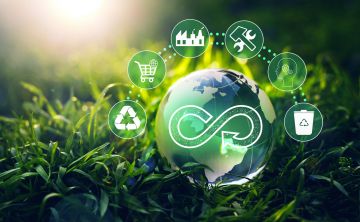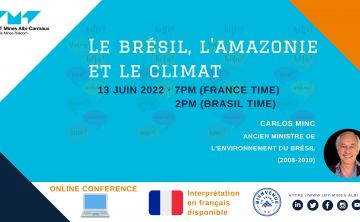Design for end-of-life, a missing link in the circular economy
An interview with Professor Didier Perrin, research professor at IMT Mines Alès and head of the Durability & Recycling of Polymers and Composites research topic within the Polymers Composites Hybrids (UPR PCH) team at IMT Mines Alès' Materials Research Center (C2MA).
Didier Perrin works on the issue of mixes of polymers and composites resulting from electric and electronic waste, end-of-life vehicles, and the marine and aeronautical industries. He is also actively involved in developing channels for recycling materials in partnership with companies, producer responsibility organizations, competitiveness clusters and schools/universities. He won the 1st Place FIEEC Carnot Applied Research Award in 2021 for his research project "Mélanie" with corporate partners ST and Suez. The circular economy and the topic of materials are taught in the new Specialized Master's PRINEC, Processes and Resources for Circular Economy Engineering in collaboration, a program jointly offered by IMT Mines Albi and IMT Mines Alès, with support from the Valdelia producer responsibility organization.
How would you define 'circular economy'?
According to its basic definition, the circular economy means producing goods and services in a sustainable way by limiting resource consumption and waste, as well as waste generation. The goal is to adopt a circular approach to replace the obsolete, outdated "throwaway" model whereby a product will necessarily go through the stages of extraction (raw materials), manufacturing, consumption and end up as waste. But it seems to me that the definition of the circular economy must be expanded in two ways.
First of all, it must address eco-design in a broad sense, meaning that it must take into account product durability, the quality of the recycled materials used to manufacture products, and improve repairability. It must also strive to better inform consumers to encourage them to make more responsible choices, and must take into account the effectiveness of our sorting and recycling processes to increase the potential for turning waste into resources.
Second, an efficient circular economy must assess environmental impacts throughout a product's life cycle: its manufacturing, use and post-use processing. Electric vehicles are a perfect illustration of this shortcoming: their use has a low environmental impact, but their manufacturing and end-of-life stage add to this impact.
So, there's a missing link in the traditional definition of the circular economy: designing products for end of life.
What would this design for end-of-life approach contribute?
Today, eco-design focuses mainly on substituting materials without looking at the consequences in terms of waste generation. Quite simply, the question of whether our collection and sorting systems are able to reinject waste into the circular economy is not considered. Waste that cannot be identified by sorting processes, for example if it is too new or too complex (combining several materials) is waste that is overlooked by sorting systems, and therefore not recycled. So ultimately, this waste generates increasingly visible sources of pollution with a high impact on living organisms and in terms of biodiversity. That's why the circular economy must strive to use high-quality secondary materials whose performance is assessed in terms of their ability to generate recycled, reusable materials. That is what design for end-of-life means, and in my view it is crucial to incorporate this approach in the circular economy.
What will the consequences be if such a systematic approach is not quickly implemented?
If no action is taken in this area, the breaking down of plastic materials will pose a problem: they will become micropolastics, which remain plastics, and are easily airborne, so they pollute the air, seep into groundwater and the ocean. They are too big to be mineralized by the enzymes in our body, but small enough to penetrate it, and have been proven to cause some types of cancer. To give you an idea, our bodies absorb the equivalent of a credit card of microplastics every week. Five billion tons of plastic have been produced since the 1950s – the equivalent of 500,000 Eiffel towers. In 2022, 70% of this production still exists as waste. In France, household waste accounts for 10% of the 5 tons of waste generated per year per inhabitant. So yes, urgent action must be taken, and expertise in materials must be upheld as the cornerstone of recycling efficiency.
What are the key factors for such an approach to be successfully implemented?
The first condition is that all of the stakeholders engage in dialogue and work together to shape the circular economy. If we look at the example of telephones today, no system can be recycled. In order for design for end-of-life to work, it has to be based on a system of extended producer responsibility which encourages manufacturers to:
- commit to a process in which they recover their waste and implement specific processing methods
- reduce the impact of raw material extraction and integrate a maximum of recovered or recycled materials in their products
- prevent waste generation by increasing product lifetimes while being responsible for their end-of-life processing, including eliminating waste that cannot be recovered, since the economy is only circular when the disposal of waste is miniscule.
Lastly, an aspect that must not be overlooked is maintaining product functionality, which is imperative for manufacturers to accept such an approach.
Could you give us a concrete example of design for end-of-life?
I'll go back to the example of mobile phones. They are composed of a myriad of materials, including many precious metals or rare earths, which are high-demand resources. They are just waiting to be recovered, except that telephone design is such that this is impossible. The components are mostly clipped on or encased and are not recyclable. Lastly, planned obsolescence encouraged by manufacturers is also a big problem. Consumers are conditioned to replace telephones that work perfectly well.
In light of all this, we need a real paradigm shift, namely managing product design by aligning the upstream stages based on eco-design, and the downstream stages based on the end-of-life strategy, which must be considered from the research phase.
Going back to our telephone example, this means manufacturers working with recycling stakeholders in advance to anticipate the future of their waste and the opportunity to recover it, by creating new processing channels if necessary. Such an approach would allow manufacturers to design telephones that can be integrated into the circular economy, by taking into account the durability of materials or opting for components that are upgradable, interchangeable or easily dismantled, for example.





